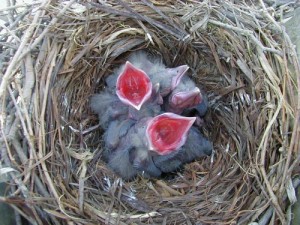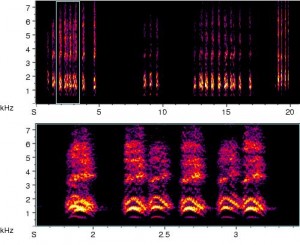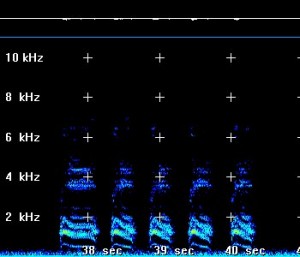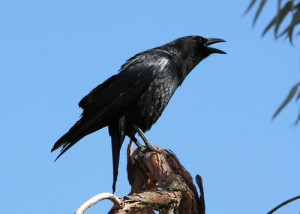We’ve all heard the sound of a single crow’s caw loud in the morning air, but did you ever question how the American Crow, or Corvus brachyrhynchos, produces the vocalizations it does? How does the American Crow get its caw, and what is its purpose? Does the American Crow emit other sounds or calls, and what is its song?

Figure 1: American Crow nestlings; http://nestwatch.org/wp-content/uploads/2014/01/American-Crow-nestlings-MNDY02-10do-26Apr02-Ithaca-Tompkins-Co-NY-kjm783-500×375.jpg
The American Crow starts its song development young, nestlings practicing peeps that are hardly audible to a person standing below tree (Verbeek & Caffrey, 2002). As they get older and grow into fledglings, they begin to produce guttural sounds. These noises, similar to gargling, oddly enough, have little to no organization or structure. Finally once the birds are 1 to 2 years old they will cycle through different types of caws as they explore their surrounding environments (Verbeek & Caffrey, 2002).
Basic calls in the form of caws and its variants are innate, and crow song is a long string of these different caws. The American Crow can learn to mimic other sounds however, such as the Barred Owl, cats, dogs, geese and even humans (Verbeek & Caffrey, 2002).

Figure 2: Spectrogram of American Crow song; http://celebrateurbanbirds.org/wp-content/uploads/2014/02/American-Crow-spectrogram-300×245.jpg
So what does the song that the American Crow developed sound like? The song of the American Crow “consist a mixture “of many types of sound elements—coos, caws, rattles, clicks, and grating noises—arranged in long sequences that have a rambling, improvised quality” (Brown 1985c)” (Verbeek & Caffrey, 2002). The adult American Crow song is much more consistent than its chaotic earlier form when the bird is in the juvenile vocal stage, but maintains some of its quirks.
Used primarily in short distance communication by all ages, the American Crow song is sung by both sexes, often in groups (Verbeek & Caffrey, 2002). Through vocal imitation the American Crow achieves a shared repertoire with those who share a territory, which is learned in the group dynamic (Verbeek & Caffrey, 2002). This creates different song dialects within groups of American Crows. An example of this sound can be heard here.

Figure 3: Spectrogram of American Crow call; http://www.crows.net/analysis.html
The American Crow uses a wide repertoire of calls, and its syrinx has 6 pairs of syringeal muscles (Verbeek & Caffrey, 2002). The most common call is the caw, which is produced 2-5 times in one bout. The calls of the American Crow encode for important information; a recent study by Mates et. al. found that they could determine the sex and identity of an American Crow based on its caw (Mates et al., 2014). Another Study done earlier backs this up, concluding that there are five distinct differences between male and female American Crow song, most notably call frequency (Yorzinski & Vehrencamp, 2006).
An example of a useful American Crow call is the short caw, which is an alarm call, especially when there is an intruder (Verbeek & Caffrey, 2002). As can be seen in this spectrogram of an American Crow call, there are five distinct caws in this instance. One study notes that the alarm calls of the American Crow can convey varying levels of urgency based on duration of the call and how quickly it is repeated (Yorzinski & Vehrencamp, 2009). An example of this sound can be heard here.
Vocalizations of the American Crow have many different uses. For example, in a Bowing Display, the bird bobs its head than bows, and makes a ca-a call. This is used during courtship or in social settings (Verbeek & Caffrey, 2002). In a defense display however, the bird caws repeatedly to scare off predators (Verbeek & Caffrey, 2002).
In a recent study it was found that “mobbing calls of two large passerines (blue jay and American crow) elicited stronger responses from captive raptors than did mobbing calls of two small passerines (black-capped chickadee and blue-headed vireo)” (Consla & Mumme, 2012). This illustrates how the caws of American Crows can be very effective in mobbing raptors.

Figure 4: American Crow calling; http://4.bp.blogspot.com/-IqTI7-MzMwQ/ThrvSKubI4I/AAAAAAAAA2g/ j5rxfnsSG_Y/s1600/crow_2.jpg
Not much is known about the daily singing pattern of the American Crow, and studies in this field would greatly expand our knowledge of the bird (Verbeek & Caffrey, 2002). Perhaps an observational study of American Crow territories tracking correlations between times when the birds sang would be sufficient.
The caw of the American Crow is a sound known to people all over the world, though the story behind it is little appreciated. Through learning the development and uses of the vocalizations of the bird, maybe we can understand more surrounding the renowned call of the American Crow.
Works Cited
Consla, D. J., Mumme, R. L. (2012), Response of Captive Raptors to Avian Mobbing Calls: the Roles of Mobber Size and Raptor Experience. Ethology, 118: 1063–1071. doi: 10.1111/eth.12007
Mates, A., Tarter, R., Ha, J., Clark, A., & McGowan, K. (2014). Acoustic profiling in a complexly social species, the American crow: Caws encode information on caller sex, identity and behavioural context. Bioacoustics: The International Journal of Animal Sound and Its Recording,24(1). Retrieved December 10, 2014, from http://www.tandfonline.com/doi/full/10.1080/09524622.2014.933446#tabModule
Verbeek, N. A. and C. Caffrey. 2002. American Crow (Corvusbrachyrhynchos), The Birds of North America Online (A. Poole, Ed.). Ithaca: Cornell Lab of Ornithology; Retrieved from the Birds of North America Online: http://bna.birds.cornell.edu/bna/species/647doi:10.2173/bna.647
Yorzinski, J., & Vehrencamp, S. (2009). The Effect of Predator Type and Danger Level on the Mob Calls of the American Crow. The Condor,111(1), 159-168. Retrieved December 11, 2014, from http://www.jstor.org/stable/10.1525/cond.2009.080057
Links:
CROW Caw – its Birdsong – AV [Motion picture]. (2008). ESL and Popular Culture.
Simpson, F. (2010, December 1). Sounds et Sonograms. Retrieved December 11, 2014, from http://www.fssbirding.org.uk/americancrowsonogram.htm
